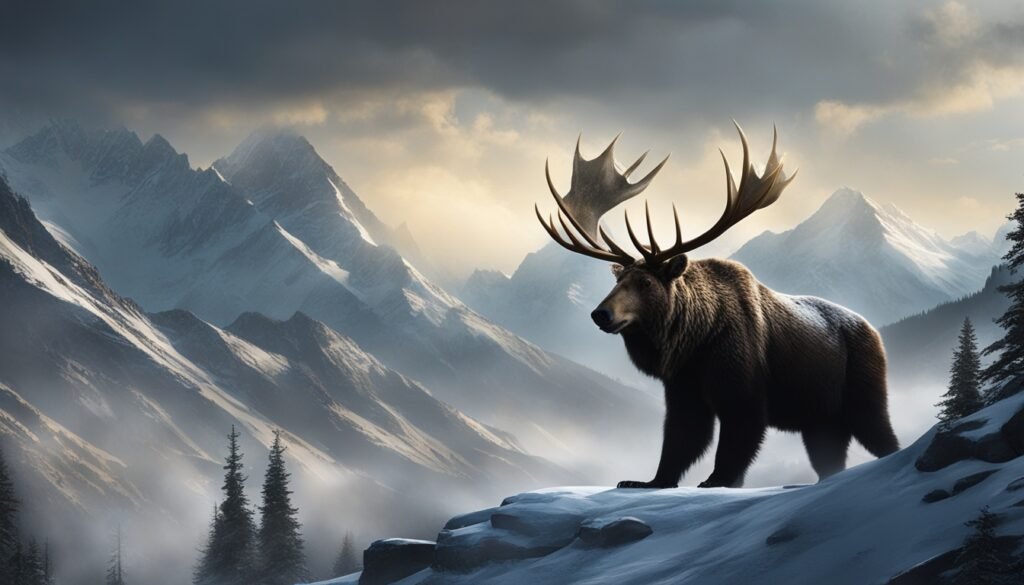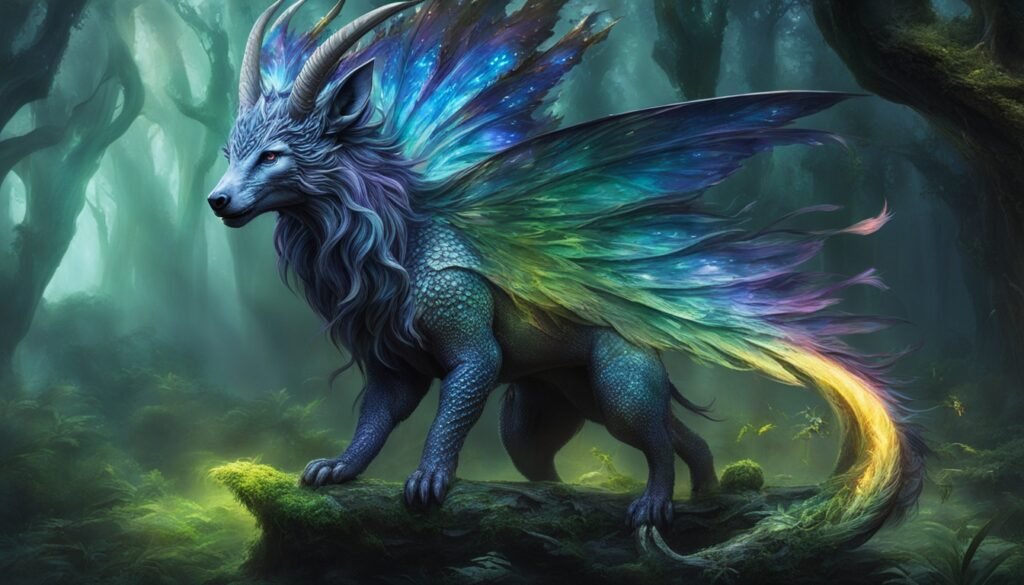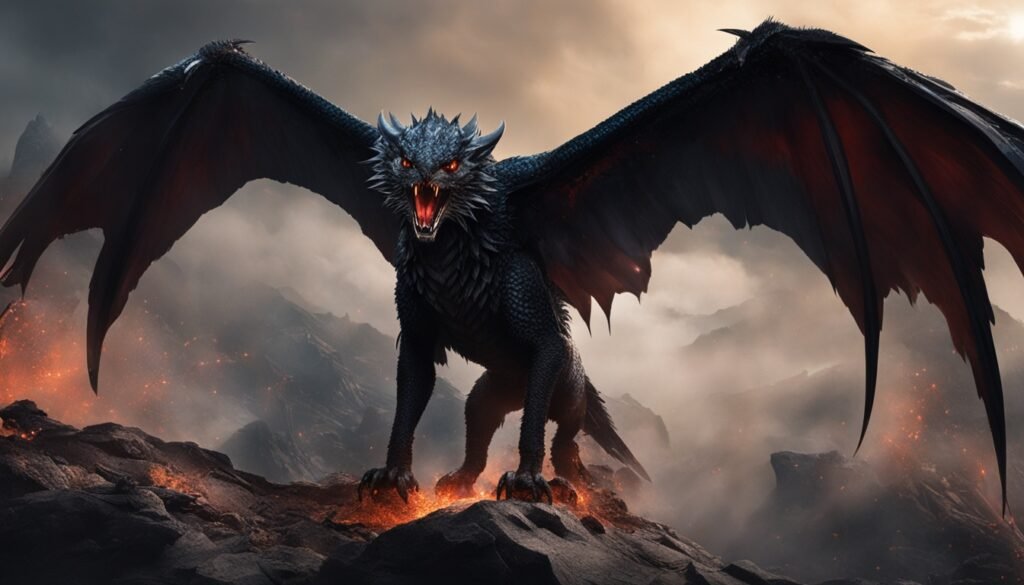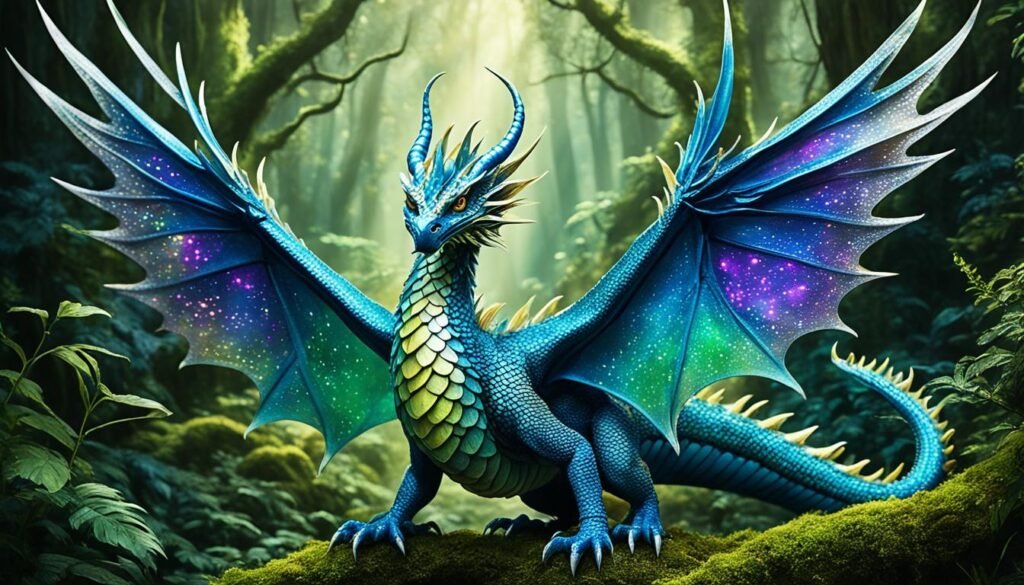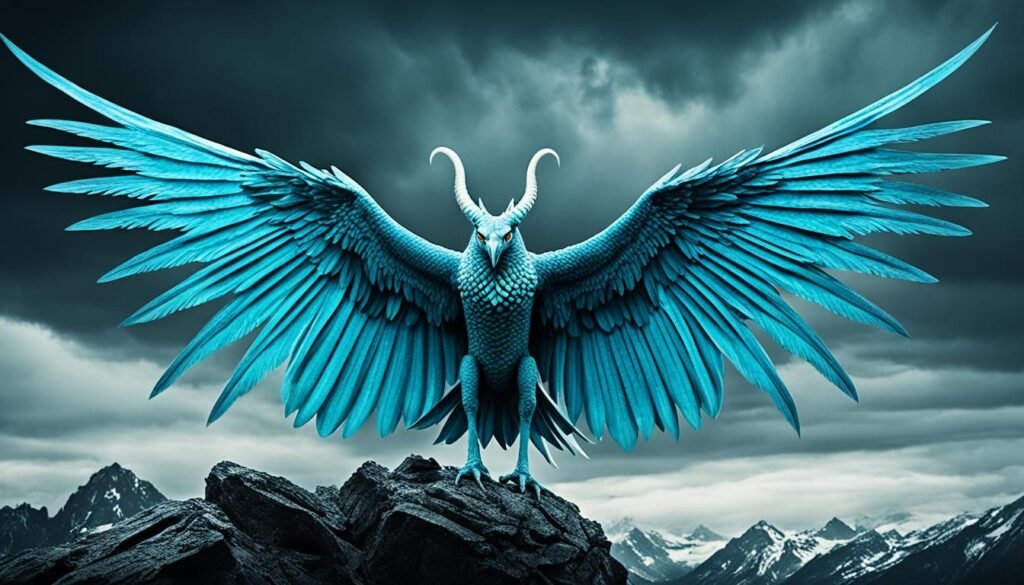Mythical Creatures : For centuries, mythical creatures have fascinated people, leading to countless tales. These beings, from sea serpents to ogres, are described in many intriguing ways. By exploring folklore and mythology, we find out how these creatures are brought to vivid life.
Key Takeaways : Mythical Creatures
- Mythical creatures are imaginary beings with supernatural or extraordinary qualities, often found in folklore, legends, and mythology.
- People have described these fantastical creatures in vivid detail, capturing their physical attributes, behavioral traits, and the awe they inspire.
- Descriptions of mythical creatures often defy the laws of nature, blending elements of the real and the imaginary.
- The enduring appeal of mythical creatures lies in their ability to captivate the human imagination and reflect the diverse cultural traditions and beliefs of people around the world.
- Mythical creatures continue to be a source of inspiration for literature, art, and popular culture, showcasing their timeless allure.
Introduction to Mythical Creatures
Mythical creatures have interested people for years. They bring to life stories and legends. From unicorns to Krakens, they exist in the tales of many cultures. These beings have played a key role in shaping myths and stories that define people and their beliefs.
What Are Mythical Creatures?
Mythical creatures are not real but are described in stories and legends. These tales often give them special powers, like breathing fire. People created them to make stories more exciting or to explain things they didn’t understand.
Purpose of Mythical Creatures
Mythical creatures have many meanings in stories. They can be symbols of power or protectors. For example, the Kraken shows the might of the sea. The griffin and the phoenix represent ideas like bravery and rebirth.
They can make us feel amazed, scared, or curious. But, mythical creatures are a big part of cultures worldwide. Their stories have been passed down for generations and continue to interest people today.
Sea Creatures of Myth
The deep ocean has always been a place of mystery and adventure. It inspired tales of mythical creatures from different cultures. Two famous examples are the Leviathan, a huge sea serpent, and the Kraken, a big octopus-like beast. These creatures stand for the ocean’s power and its risks. They show how bravery and quick thinking are vital for ocean travel.
Leviathan: The Giant Sea Serpent
The Leviathan is a giant sea serpent from Middle Eastern stories. It was thought of as a huge challenge for those sailing the seas. The Leviathan was so big that it could swallow entire ships. Its power and vastness amazed anyone who heard about it.
Its myth warns about the ocean’s dangers, teaching sailors to be careful and bold on their journeys. The Leviathan’s link to the deep, unknown parts of the sea makes it a key part of worldwide ocean myths.
The Kraken: A Nordic Sea Monster
The Kraken is a well-known monster from Nordic myths. It’s described as a huge octopus-like creature, big enough to cover a small island. Sailors feared its presence in the deep, dark waters of the north.
Stories of the Kraken pulling sailors to their deaths are still told today. It’s a symbol of the ocean’s deadly surprises, always reminding people to stay alert and ready.
The Leviathan and the Kraken are still popular today, hinting at the ocean’s many secrets and perils. They stand as reminders of the unknown parts of the sea where mythical sea creatures dwell.
“The ocean is a place of mystery, a realm where the imagination can run wild and the possibilities are endless.”
Forest Dwellers
Forests have been seen as mysterious and risky in stories, spawning many mythical forest creatures. For instance, there’s Kijo, a female ogre from Chinese and Japanese forest folklore and mythology. She lures humans into the woods, plays tricks on them, and might even harm children.
Kijo and other ogres and trolls in the forest are warnings. They warn us of hidden dangers in the wild and the risks of going too far from home. These creatures are part of forest folklore and mythology worldwide. They affect how we see and live with nature.
Kijo: The Child-Eating Ogre
Kijo, the child-eating ogre, is a key figure in forest folklore and mythology. She’s known to lure kids into the forest, where she eats them. Kijo’s story warns children to listen to their parents and avoid dark, scary woods.
“Kijo, the child-eating ogre, is a particularly chilling figure in forest folklore and mythology. This female mythical forest creature is said to lure unsuspecting children into the woods, where she then devours them.”
Kijo’s legend and those of other ogres and trolls highlight our fear of the unknown and the dangers of the wild. These mythical forest creatures help people understand survival, hunting, and the value of life in the face of nature’s wildness.
The story of Kijo the child-eating ogre and others shows their lasting impact in forest folklore and mythology. They help us connect with nature and question our role in it. As our knowledge of the forest extends, ogres and trolls will keep sparking our interest. They remind us of our relationship with nature.
Mountain Legends
The world’s mountainous regions have rich tales of mythical beings. Their grandness and mystery have sparked imagination worldwide. Two renowned creatures are the Yeti, a Himalayan Bigfoot, and Idris, a legendary Welsh giant.
The Yeti: Bigfoot of the Himalayas
The Yeti, or “Abominable Snowman,” is a legendary figure of the perilous Himalayas. It’s described as a huge, furry, bipedal creature. Many liken it to North America’s Bigfoot for its mystery and rarity. Numerous accounts of the Yeti exist, driving multiple expeditions into the Himalayas to seek it.
Idris: The Welsh Mountain Giant
Another figure is Idris, a giant in Welsh myth, believed to inhabit Cader Idris. Idris is an anthropomorphic being, part human and part beast. Legend says sleeping on Cader Idris can lead to madness or poetic brilliance, highlighting the mountain giant’s power and wildness.
These mythical mountain beings are more than folklore. They symbolize the mystery and harsh beauty of high-altitude landscapes. They draw us with a mix of fear and fascination, making the mountains’ unknowns captivating.
Mythical Creatures
The world of mythical creatures is like a rich tapestry, full of incredible beings that have amazed people for ages. They range from the kind and beautiful to the scary and dangerous. These creatures have big and magical bodies, powers that go beyond nature, and ways of acting that we can’t understand. They might protect the woods, bring warnings of trouble, or stand for powerful primal energy. Mythical creatures have been key in creating the stories and traditions of many different cultures worldwide.
Every region and nation has its own set of legendary creatures, making the myth world incredibly vast. Each has its quirks but many share traits like flying, breathing fire, or being super strong. Some look like totally mixed-up animals, such as a lion’s head on a bird’s body. Others might have other-worldly powers or be able to change shape. Even with all these differences, these beings have always grabbed our minds, pushing artists, writers, and storytellers to bring them to life over and over.
“Mythical creatures are the embodiment of our deepest fears, our wildest dreams, and our most profound mysteries.”
Mythical beings are linked to everything from guarding hidden treasures, foretelling dangers, to embodying the wild side of nature. They manage to fascinate us all, sparking our wonder about what’s out of our reach. Creatures like the Yeti in the Himalayas or the Chupacabra in Latin America keep our curiosity alive, showing us the endless reaches of the human mind’s creativity.
Modern Mythical Creatures
Many mythical creatures come from old tales, but new ones are still being created today. These modern beasts might explain things we can’t, like strange events. Or they could be warnings about dangers ahead. This shows people always want to understand what they don’t know.
The Mothman: A Harbinger of Danger
The Mothman is a big, flying creature seen around Point Pleasant, West Virginia. Stories about it started in the late 1960s. People who saw it said it looked like a huge bird with glowing red eyes.
Some say the Mothman’s arrival foretold the Silver Bridge disaster in 1967. This event killed 46 people. Now, the Mothman is part of today’s stories and warnings, with books, movies, and even a museum in Point Pleasant.
The Chupacabra: A Blood-Sucking Beast
The Chupacabra is another exciting example. It’s a creature that supposedly sucks the blood of animals in Latin America and parts of the south U.S. Its story began in Puerto Rico in the 1990s.
People say it looks like a reptile, stands on two legs, and has spikes on its back. It often harms farm animals. People still report seeing the Chupacabra, inspired by it to create new legends.
This interest in mysterious mythical creatures indicates a deeper curiosity within us. So, stories about the Mothman, Chupacabra, and others keep emerging. They remind us the world is mysterious and full of stories yet to be told.
Describing Mythical Creatures
Authors use exciting words to describe mythical creatures. They talk about their size, strength, and looks. Creatures can be deadly, muscular, magnificent, or gigantic. Words like striking, rapid, minuscule, adorable, and enchanting also show how they look and act.
Physical Attributes
Mythical creatures vary in size and shape. Some are as small as fairies, while others are as big as the Leviathan, a sea serpent. They have unique features like the Kraken’s gigantic tentacles or the Yeti’s thick, shaggy fur. These details help us imagine these mysterious beings.
Behavioral Traits
These creatures also have interesting behaviors. For example, the Kijo is a scary ogre that eats children. And the Mothman warns of danger. Describing how these creatures act adds to their mystery and allure.
| Physical Descriptions | Behavioral Characteristics |
|---|---|
|
|
Authors pick special words to make creatures seem real. This excites our imagination. The details about how they look and act are key. They make us feel curious and fascinated.
The Enduring Appeal of Mythical Creatures
Mythical creatures have fascinated people for ages, thanks to various reasons. They help explain the unexplainable, adding wonder and adventure to our lives. They also let us tackle our fears and dreams in a safe way.
These creatures change with the times, staying interesting to new generations. They can be found in ancient stories, current films, and more. This shows our ongoing love for the extraordinary.
Mythical creatures help us deal with life’s big issues like death and power. They are like mirrors reflecting our deepest emotions and thoughts. This makes them powerful tools for self-discovery.
These entities are loved by people worldwide, not bound by culture or time. Dragons from China and Bigfoot from North America both show this. They inspire and connect us.
Mythical creatures fire up our minds and make us think in new ways. As we keep searching the world, they will always be there. They are a symbol of how creative and curious we are.
Cultural Significance
Mythical creatures are key in many cultures’ art and stories. They’ve fascinated people for years, creating a shared story worldwide.
Mythical Creatures in Literature
Authors from long ago like Homer to modern writers such as J.R.R. Tolkien use mythological creatures. They are used as symbols and to tell stories. This shows our love for the adventures and unknown.
Mythical Creatures in Art
In art, these creatures shine brightly. Artists, now and in history, painted and sculpted them. Whether in Chinese art or old manuscripts, they inspire our creativity and awe.
Mythical creatures are part of many cultural stories. They bring us together, telling tales that go beyond time and place. They help us dive into our shared dreams and imaginations.
| Mythical Creatures in Literature | Mythical Creatures in Art |
|---|---|
|
|
“Mythical creatures show our deep need to discover and dream beyond what we know.”
Also Read : Why People become Criminals? The Problem Of Liberty
Conclusion
The world of mythical creatures has fascinated people for ages. It showcases the rich history of storytelling and different cultures worldwide. Creatures like the Leviathan and Kraken from the seas, to the Yeti in the mountains, are just a few examples. They’re seen as dangerous icons, nature’s spirits, or simply something that brings joy.
Looking at these myths helps us peek into what makes us human. We long to grasp the unknown and assign meaning to our world. Sea creatures, forest spirits, or mountain monsters, they all capture our minds. They fuel our imaginations, change how we see things, and remind us of endless possibilities.
Their legacy proves our endless interest in the unknown and the magical. It shows our need to venture beyond and seek comfort in wonders not yet explained. Exploring these myths means delving into our own minds. It’s a journey offering wisdom about being human and the vast creativity of the human mind.
FAQs
What are mythical creatures?
Mythical creatures are beings from stories and myths. They come from different cultures and have unique qualities. These beings are not real but spark our imagination.
What is the purpose of mythical creatures?
They help explain unknown things and warn about dangers. They also add excitement to stories and adventures. Mythical creatures often have amazing powers and play a big role in many cultures’ stories.
Can you provide examples of mythical sea creatures?
Indeed, there are many sea creature myths. The Leviathan is a huge sea serpent from the Middle East. And there is the Kraken, a gigantic octopus from Nordic tales.
What are some mythical forest-dwelling creatures?
One such creature is Kijo, a scary ogre from China and Japan. She wanders forests, fearing children. Stories about Trolls warn people to be careful in the woods.
Can you describe some mythical mountain-dwelling creatures?
Sure. We have the Yeti, a mysterious Bigfoot in the Himalayas. There’s also Idris, a giant in Wales who lives on a high mountain. These creatures with human-like features live in the mountains.
What are some common characteristics used to describe mythical creatures?
Writers often use strong and vivid words to describe these beings. They might say a creature is “huge,” “beautiful,” or “scary.” These words help paint a clear picture.
Why do mythical creatures continue to captivate the human imagination?
Mythical creatures are intriguing because they offer answers and let us face fears. They can change with time, still finding new stories to connect with people.
How are mythical creatures represented in cultural and artistic expression?
They have a strong presence in books, art, and culture. These creatures are not just characters, but they carry deep meanings. Their stories link people worldwide over many years.
Source Links
- https://writingtipsoasis.com/words-to-describe-a-mythical-creature/
- https://study.com/academy/lesson/mythical-creatures-guide-names-types.html
- https://www.reddit.com/r/writing/comments/xyp15/describing_mythical_creatures/

